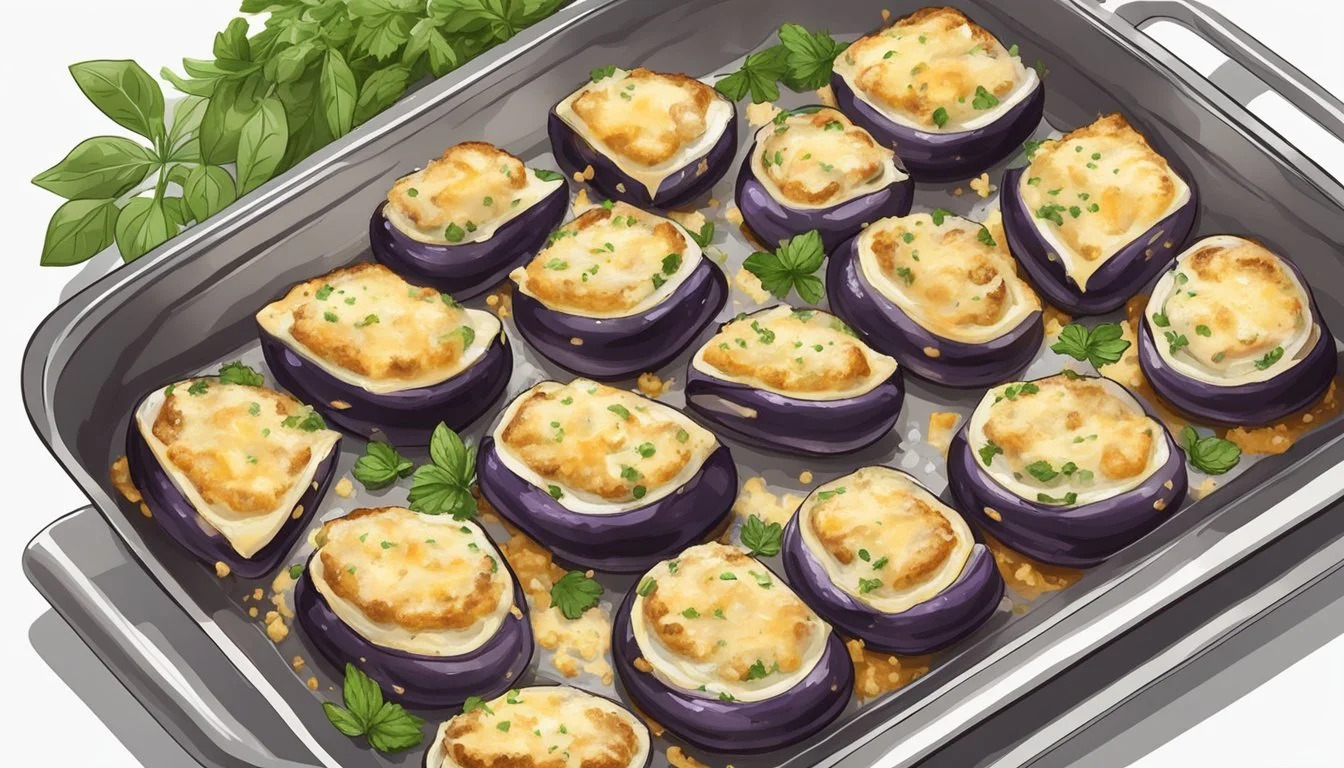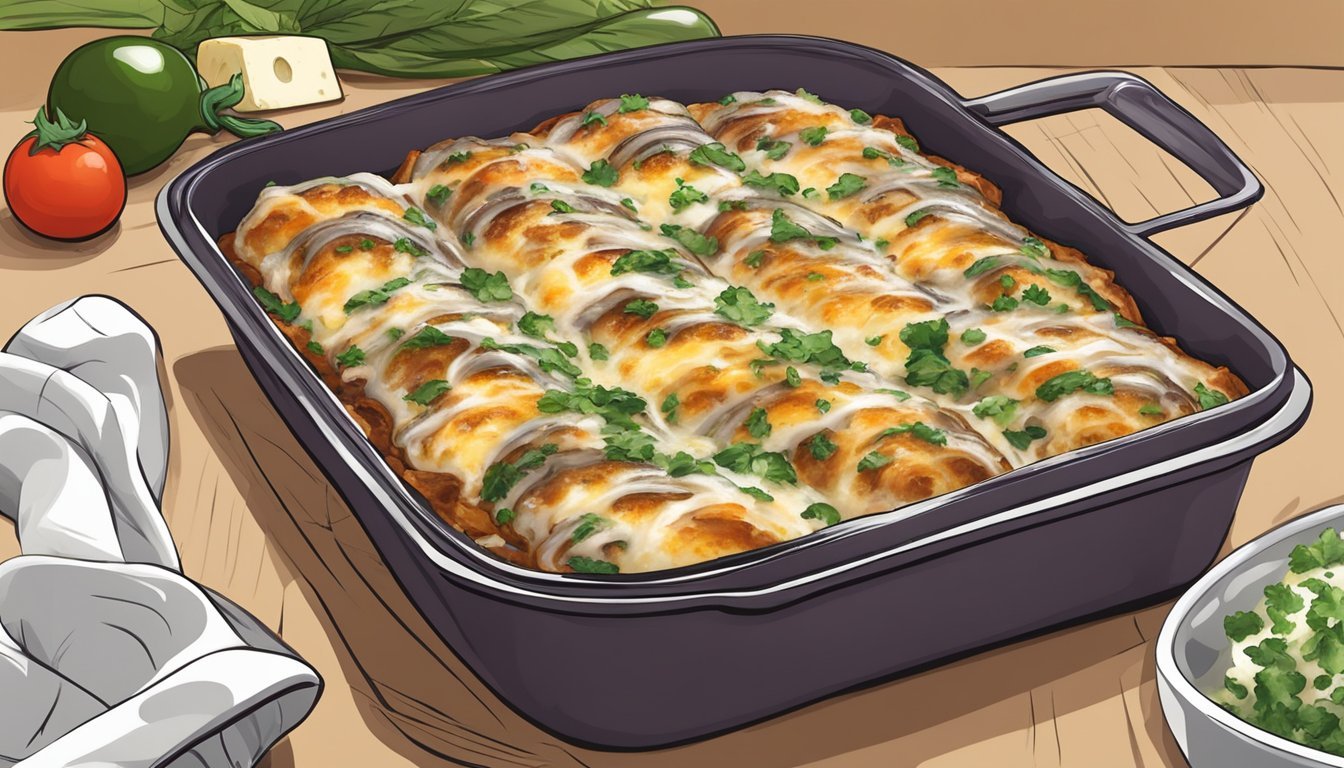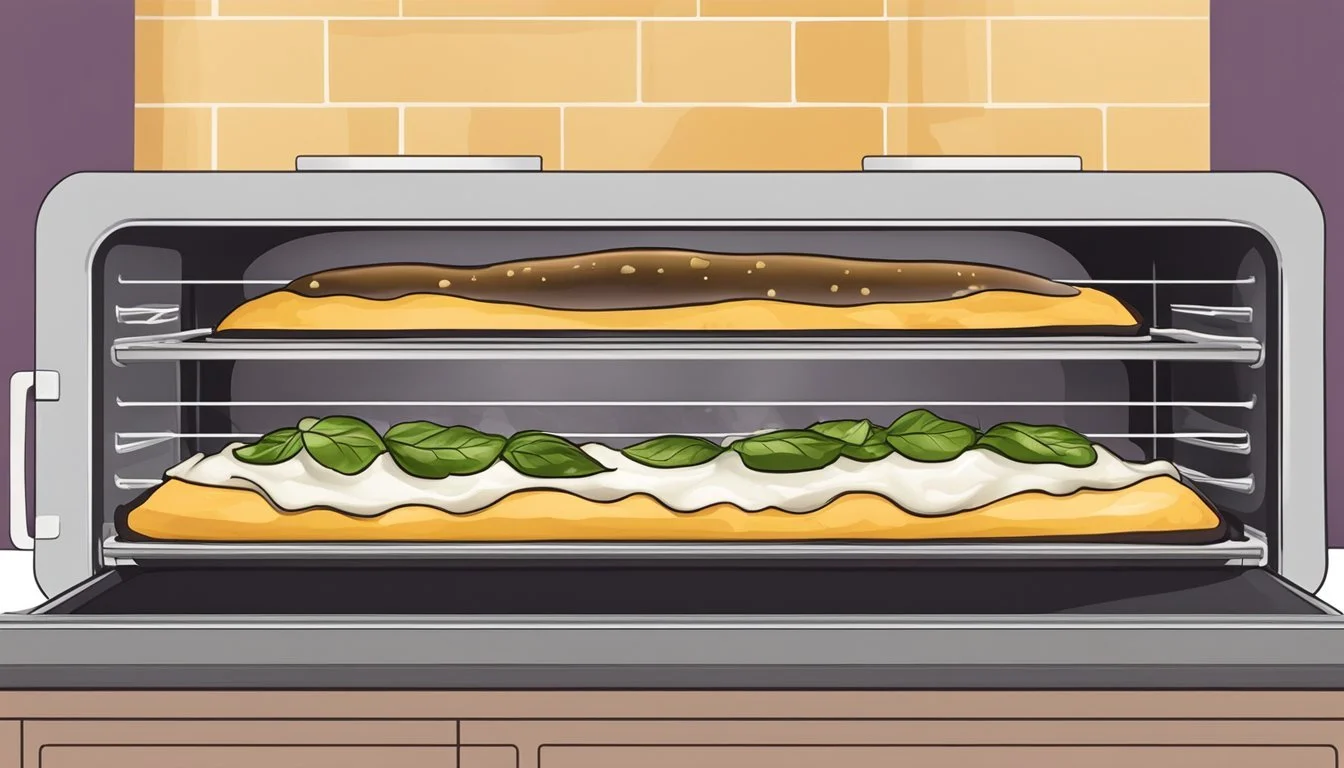Best Way to Reheat Eggplant Rollatini
Ensuring a Cheesy, Flavorful Dish
Eggplant rollatini, with its tender slices of eggplant wrapped around a succulent, cheesy filling and topped with marinara sauce, offers a delightful Italian culinary experience. The dish can be enjoyed fresh out of the oven, but the question arises on how to revive the flavors when faced with leftovers. Reheating eggplant rollatini is not just about warming it up; it's a careful process to ensure that the dish retains its moist cheese filling, the soft yet firm texture of the eggplant, and the rich taste of the marinara sauce.
For those who prefer their dishes perfectly heated with a texture that mirrors the original cooking, certain methods of reheating are more effective than others. It involves gentle warming that redistributes the heat without overcooking or drying out the components. The process can vary depending on the tools available, whether one is using an oven or a microwave.
Understanding the characteristics of eggplant rollatini is crucial to achieving a reheated dish that feels as though it has just been made. Eggplants are particularly absorbent and can become soggy if not treated properly, while cheese has a tendency to separate or become rubbery under high heat. Thus, a balanced approach that takes into account the unique qualities of each ingredient is essential to serve a dish that’s as enjoyable as when it was first prepared.
Understanding Eggplant Rollatini
Eggplant Rollatini is a cherished Italian dish known for its rich blend of savory cheeses and the complementary acidic sweetness of marinara sauce. This section will guide you through the fundamentals of Eggplant Rollatini, from its definition to the core flavors that make it a beloved vegetarian option.
What Is Eggplant Rollatini?
Eggplant Rollatini is a classic Italian dish that features thinly sliced eggplant wrapped around a core of creamy ricotta, gooey mozzarella, and savory parmesan cheeses. This rolled creation is then generously topped with marinara sauce and baked until the flavors meld into a warm, comforting entrée.
Components and Ingredients
Eggplant: The base of the dish, sliced into thin strips and often pre-cooked to soften.
Cheeses: A trio of ricotta for creaminess, mozzarella for meltiness, and parmesan for a sharp depth of flavor.
Marinara Sauce: A tomato-based sauce that balances the richness with its acidity.
Seasonings: Fresh basil and a blend of Italian herbs reinforce the classic Italian flavors.
The dish can cater to gluten-free preferences when no breadcrumb coating is used, making it versatile for various dietary needs without compromising on taste.
Key Flavors and Textures
The textural contrast in Eggplant Rollatini arises from the soft, almost creamy texture of the baked eggplant against the thick and stringy quality of melted mozzarella. The ricotta adds a velvety component to the filling, while the parmesan introduces a granular bite. Flavor-wise, the dish is a symphony of classic Italian flavors—herbaceous notes of basil, the umami from the cheeses, and the sweet yet tangy profile of the marinara sauce. Together, they create a harmonious balance that defines Eggplant Rollatini.
Preparation Before Reheating
Properly storing and preparing eggplant rollatini is crucial for maintaining its flavor and texture. Adhering to optimal storage, freezing, and thawing techniques ensures that when it comes time to reheat, the dish remains as delicious as when it was first made.
Storing Eggplant Rollatini
To keep eggplant rollatini fresh in the refrigerator, one should:
Place the rollatini in an airtight container immediately after it cools.
Ensure the eggplant rollatini is stored at or below 40°F to prevent bacterial growth.
The dish can be refrigerated for about 2-3 days while maintaining its quality.
Freezing Advice
For those who like to prepare meals ahead of time, freezing eggplant rollatini is a viable option:
Allow the dish to cool completely before freezing to avoid ice crystal formation.
Wrap the rollatini tightly in plastic wrap, followed by aluminum foil.
Eggplant rollatini can be frozen for up to 3 months. Label with the freezing date to keep track of freshness.
Thawing Techniques
Thawing frozen eggplant rollatini requires patience and proper technique for the best results:
Transfer the frozen rollatini to the refrigerator and allow it to thaw overnight.
Avoid using a microwave to thaw as this can affect the texture and temperature of the dish.
Thawed eggplant rollatini should be reheated and consumed within 24 hours for optimal taste.
Reheating Methods
Proper reheating techniques ensure that eggplant rollatini retains its flavor and cheese remains deliciously melted. One should consider the temperature and container used for reheating to maintain the dish’s integrity.
In the Oven
Reheating eggplant rollatini in the oven is ideal for achieving a texture similar to when it was first baked. Preheat the oven to 350°F (180°C). Place the leftovers in a baking dish or casserole dish and cover it loosely with aluminum foil to prevent the cheese from burning. Heat for about 20-25 minutes, checking periodically to ensure even warming.
Using a Microwave
For a quicker option, use a microwave. It does not produce the same crispiness as an oven but is efficient. Place the eggplant rollatini in a microwave-safe dish, covering it to retain moisture yet vented to allow steam to escape. Microwave on a medium setting for 1-2 minutes. Check if it's thoroughly warmed, especially in the center, before serving.
Skillet Reheating
Skillet reheating provides a good balance between speed and texture. Heat a skillet over a medium flame. Add the baked eggplant rollatini slices and cover the skillet with a lid to trap heat and melt the cheese. Cook for a few minutes, then flip carefully to ensure both sides are evenly heated. This method helps to restore some of the dish's original crispness.
Ensuring Cheesiness and Flavor
To maintain the decadent cheesiness and robust flavor of eggplant rollatini, one must carefully manage the cheese during reheating and enhance the dish with herbs and spices afterward.
Cheese Management During Reheating
When reheating eggplant rollatini, the goal is to ensure that the cheeses—ricotta, mozzarella, and parmesan—remain moist and flavorful. To achieve this:
Ricotta filling: Keep the ricotta filling creamy by reheating the rollatini covered, thus retaining the moisture. Use a preheated oven at 350°F and cover the dish with aluminum foil.
Mozzarella cheese: To prevent drying out, a sprinkle of water or extra marinara sauce over the rollatini can be useful before covering with foil.
Parmesan cheese: Add a fresh grate of parmesan cheese on top after reheating to enhance its nutty and salty flavor profile.
Herbs and Spices Post-Reheating
The application of herbs and spices can significantly affect the final flavor of the dish. For optimal taste:
Fresh herbs: Incorporate finely chopped basil, oregano, or parsley after reheating to bring a fresh and aromatic character.
Seasoning: Adjust the seasoning with a small pinch of kosher salt and black pepper to elevate the natural flavors of the cheese and eggplant.
Heat element: For those who prefer a bit of spice, a light dash of red pepper flakes can add a desirable warmth to the dish.
By carefully reheating eggplant rollatini and applying these tips, one ensures that the cheese maintains its delightful texture and that every bite is full of savory flavors and aromatic herbs.
Side Dishes and Pairings
Selecting the perfect side dish enhances the main course, especially with a dish like eggplant rollatini. Balancing flavors and textures is crucial; lighter sides like salads provide a contrast to the rich and cheesy rollatini, while gluten-free and bread options ensure everyone at the table can enjoy the meal.
Salads and Vegetables
Salads: An arugula salad with a lemon vinaigrette offers a peppery bite and a zesty freshness that cuts through the richness of the rollatini.
Vegetables: Side dishes like eggplant caponata present a medley of flavors while maintaining a consistent theme. Alternately, grilled or roasted vegetables can add a smoky dimension to the meal.
Gluten-Free Options
Gluten-Free Pasta: Serving a side of gluten-free pasta with a light sauce complements the main dish without overshadowing it.
Low Carb Sides: For a low-carb alternative, one can offer slices of eggplant lasagna where thin slices of eggplant substitute traditional noodles.
Complementary Breads
Crusty Bread: A slice of crusty bread is ideal for mopping up the rich tomato sauce that often accompanies eggplant rollatini.
Gluten-Free Bread: There are numerous gluten-free bread options that are perfect for those avoiding gluten yet still wanting to enjoy the saucy goodness of the rollatini.
Advanced Tips and Tricks
The successful reheating of Eggplant Rollatini hinges on preparing it efficiently and avoiding common errors that could compromise its flavor and cheesy goodness.
Preparing Eggplant for Optimal Reheating
For Eggplant Rollatini, which is a delightful blend of tender eggplant and rich cheese, the key to preserving its texture and taste during reheating starts with the preparation stage. Use a mandolin or a sharp knife to cut the globe or Italian eggplant into uniform slices, ensuring they cook evenly. When making Eggplant Rollatini, include an ample amount of cheese, which helps retain moisture and creaminess upon reheating. It's recommended to prepare the dish as involtini di melanzane, small bundles that ensure a consistent temperature when warmed up.
Texture Preservation: To keep the eggplant's texture:
Make sure eggplant slices are not overly thin, as they can become too soft.
Cheese: To ensure the cheese remains creamy and delicious:
Use a blend of moisture-retaining cheeses such as ricotta and mozzarella.
Avoiding Common Reheating Mistakes
There are numerous pitfalls to avoid to ensure the reheated Eggplant Rollatini maintains its appeal.
Temperature and Timing: An oven preheated to 350°F is ideal for reheating, as it warms the dish gently without drying it out.
Reheat until the cheese is visibly melty and the interior is warm, usually around 10-20 minutes.
Texture: Prevent texture degradation with these strategies:
Cover the dish with foil to prevent the top from burning or becoming too crispy, especially when elements like eggplant parmesan or eggplant meatballs are incorporated.
If the rollatini was frozen as a make-ahead meal, thaw it in the refrigerator before reheating to ensure even warming.
Remember, a successful reheating process will not change the character of the dish but will restore its fresh-made appeal.
Final Thoughts
When one aims to reheat eggplant rollatini, the goal is to preserve the dish's hearty flavors and rich, cheesy goodness. This Italian dish, often enjoyed as a delicious meatless option, comprises thinly sliced eggplants filled with a blend of cheeses and herbs, topped with homemade marinara sauce. To maintain its authentic taste, it's crucial to approach the reheating process with care.
Reheating in the Oven:
Temperature: Preheat the oven to around 350°F, creating a gentle warming environment.
Timing: Heat the eggplant rollatini for 20-25 minutes, depending on the portion size.
Storage: If the leftovers were refrigerated properly, they would retain their taste upon reheating.
Microwave Use:
Short duration: Heat in short intervals to avoid overcooking.
Add Moisture: Introduce a teaspoon of water to prevent drying out.
Extra Virgin Olive Oil:
A drizzle of olive oil can reintroduce moisture, enhancing the flavor and texture of the eggplant.
Homemade Sauce:
An extra spoonful of homemade marinara or tomato sauce can revive the original gusto of the dish if it seems scant.
When freezing, ensure the eggplant rollatini is wrapped tightly to preserve its quality. Thawing it properly before reheating will yield the best results. Reheating methods, such as baking, can recreate the fresh-out-of-the-oven experience, making the dish a delightful encore to its initial presentation.
Understanding these tips can elevate the reheating experience, ensuring that one's leftovers are just as appetizing as when the dish was first prepared. By following these instructions, the integrity of the eggplant rollatini is protected, ensuring a culinary experience that is both satisfying and reminiscent of the original homemade meal.







